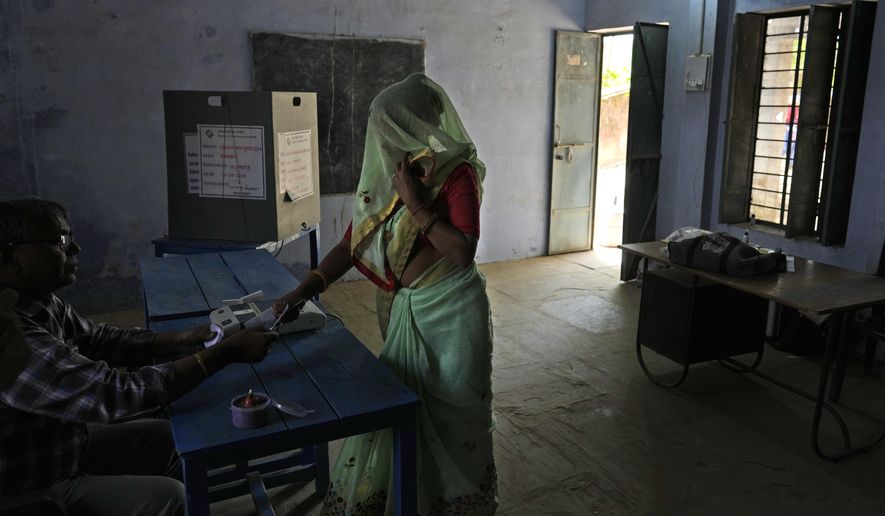The greatest exercise of democracy in the history of mankind — by the numbers, at least — kicked off Friday as almost 1 billion people began casting votes for the next leader and government of India.
In 2023, India overtook China as the world’s most populous country, with 1.4 billion citizens. Up for grabs in its elections are 543 seats in the Lok Sabha, which translates to “House of the People,” the lower house of the Indian Parliament.
According to Indian broadcaster NDTV, eligible voters number 968.6 million. That’s more than twice the population of the entire European Union, which is 448 million. India’s population has expanded by 8% since the last general elections in 2019.
In a country where ethnic and religious tensions can turn deadly, some 300,000 security personnel, in addition to local police, are being deployed to safeguard electoral officials and voting machines in over 1 million voting stations, NDTV reported.
But so huge is the voter base, so vast the territory it inhabits, and so challenging the communications in a land that encompasses sprawling cities, tropical jungles, austere deserts and snow-covered mountains, that India will not know the results of the phased vote for weeks.
A combined vote count is set for June 4.
Widespread expectations are that Prime Minister Narendra Modi, 73, will earn his third consecutive term in office.
Mr. Modi and his Bharatiya Janata Party, or BJP, promote a populist brand of politics centered on Hindu nationalism. That has resonated with many in a nation where 80% of the people are Hindus — though not with India’s 200 million Muslims.
Mr. Modi benefits from an arguably ineffectual opposition, but has also been accused of undermining democracy and using federal institutions to harass other parties.
Mr. Modi, who likes to wear traditional garments and practices yoga, got his start in politics as a cadet in the right-wing Hindu paramilitary organization Rashtriya Swayamsevak Sangh, or RSS, which means the “National Volunteers Organization.”
Climbing the political ladder, he became chief minister of his home state of Gujarat. In that position, he was accused of complicity in anti-Muslim violence during riots in 2002. Hundreds died during those riots.
Mr. Modi denied those allegations, and courts ultimately absolved him.
Since Mr. Modi became premier in 2014, critics say he has overseen a rise in intolerance and ethnic violence. In January, he famously opened a Hindu temple on the site of a 16th-century mosque razed by Hindus in the town of Ayodhya. His detractors worry that a third term could erode India’s secular polity.
But Mr. Modi enjoys high approval ratings: Polls found 75% of Indians gave his policies a thumbs-up in February.
According to the pollster IPSOS, he has earned praise for his upgrades to education, health care and sanitation. Other popular initiatives include deciding foreign policy independent of overseas powers, hosting the G20 summit and overseeing India’s successful moon landing.
The BJP enjoys widespread support in central and northern India, but faces challenges from powerful local parties in the liberal, multi-ethnic Tamil Nadu region in the south.
Key electoral issues include inflation, unemployment and Mr. Modi himself.
He has vowed to make India a fully advanced nation by 2047, which would be 100 years after it achieved nationhood. With a gross domestic product of $4.1 trillion, India is already the world’s fifth-largest economy and is ahead of former colonial power, the United Kingdom, which is in sixth place.
Key industries include agriculture, software and business outsourcing, and its growth rates have been between 6% and 8% over the last two years, bar the two years of 2019 and 2020.
The nation, however, remains racked by poverty, inequality and poor infrastructure.
If he wins a third term as prime minister, Mr. Modi will be the first to do so since India’s founding father, Jawaharlal Nehru, famed for leading India to independence in 1947.
While the U.S. and Western democracies court him as a counterbalance to China, Mr. Modi, true to Indian political tradition, is navigating a nonaligned course.
As recently as 2022, India fought deadly clashes with China over tense borders in the Himalayas. And New Delhi is deeply suspicious of moves by China’s navy in the Bay of Bengal. India is a member of the Quadrilateral Security Dialog, alongside Australia, Japan and the United States.
Yet it remains on amicable terms with Russia, with which it continues to trade, notably in energy, regardless of the Kremlin’s ongoing invasion of Ukraine.
That stance has frustrated some Western capitals.
• Andrew Salmon can be reached at asalmon@washingtontimes.com.




Please read our comment policy before commenting.